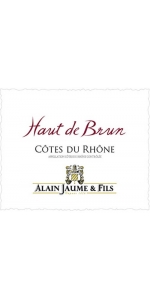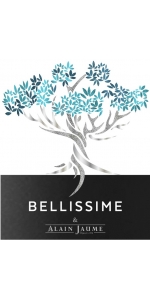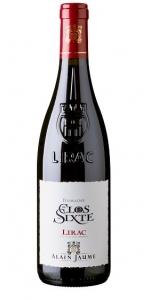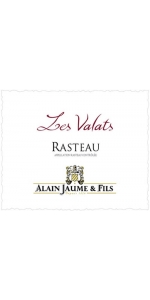Alain Jaume & Fils Domaine Grand Veneur Cotes du Rhone Blanc de Viognier, Rhone, France 2012
| Vintage: | 2012 |
| Bottle Size: | 750 ml |
All older vintage wines have been purchased from a single collectors cellar. Pictures can be requested before shipment.
Pulled from a Gentleman's cellar, all wines from this cellar have been purchased by the owner either from the importer or direct from winery. They stayed in his cellar until being moved to the Timeless Wines warehouse.
Pulled from a Gentleman's cellar, all wines from this cellar have been purchased by the owner either from the importer or direct from winery. They stayed in his cellar until being moved to the Timeless Wines warehouse.
All older vintage wines have been purchased from a single collectors cellar. Pictures can be requested before shipment.
Pulled from a Gentleman's cellar, all wines from this cellar have been purchased by the owner either from the importer or direct from winery. They stayed in his cellar until being moved to the Timeless Wines warehouse.
All older vintage wines have been purchased from a single collectors cellar. Pictures can be requested before shipment.
Alain Jaume Cotes Du Rhone Rouge Haut de Brun is made from 60% Grenache, 30% Syrah, 10% Cinsault
The colour is purple-tinged garnet.The aromatic range of the nose goes from fresh berries (wild raspberry, blackcurrant, blackberry) to spices.The palate is big and full-flavoured, with silky-smooth tannins and aromas of the fruit already mentioned. The finish introduces touches of liquorice and pepper. A Côtes du Rhône with great complexity for an every day drinking.
A classic Rhône to drink between 1 and 4 years. Best poured at 17°C.
Traditional wine making and ageing is performed in vats only. Bottling after 10-12 months.
Ideal throughout the meal, but particularly with poultry and other white meats, as well as mild cheeses.
Alain Jaume Bellissime Cotes du Rhone Rose is made from 50% Grenache Noir, 25% Cinsault, 20% Syrah and 5% Mourvedre
Salmon-pink color, clear and brilliant. The nose is fruity and spicy, reminiscent of wild strawberry and fine Provencal spices. The palate is full, well-balanced and fruity, with a long, fresh finish. A beautiful and delicate rosé.
A part is drawn off the skins with short maceration and the other part is from direct press. Fermentation in stainless steel at cool temperature. Bottling 5 months after harvest.
Alain Jaume Domaine du Clos de Sixte Lirac is made from 50% Grenache, 35% Syrah, 15% Mourvedre
An intense red garnet color. On the nose, aromas of red and black ripe fruit (kirsch and wild blackberry). The mouth is full, with aromas of blackcurrant liqueur and spice. Tannins are both harmonious and elegant thanks to the fleshiness of the wine. Hints of licorice and vanilla on the finish, which gives the wine length and complexity.
Soil type LIRAC vineyard is facing Chateauneuf du Pape, opposite side of the Rhône river. As showed by the picture and following geologist George Truc, soils are almost similar in both side. They are marked by the violence wrought by the Rhone river. It consists of a layer of marine molasses of the Miocene period covered by alpine alluvium. The presence of a great number of rounded stones known as "galets" in the earth is evidence of the time when the Rhone, then a torrent, tore fragments of rock from the Alps and deposited them on the plain. LIRAC is one of the up-coming best area from the southern Rhône valley, as it delivers outstanding wines. Winemaking & ageing Traditional wine-making in stainless still vats. Hand sorted bunches, crushed and destemmed grapes. Fermentation temperature : 30°C. 18 days of vatting with pigeages.
Alain Jaume Gigondas Terrasses de Montmirail is made from 65% Grenache the rest Syrah, Mourvèdre by less than 15%.
Deep red garnet color. Aromas of ripe and black fruits. On the palate the wine is rich, powerful and harmonious - well balanced with wild berry and pepper dominating.
Soil types
Located in and around the famous area called “Dentelles de Montmirail”, the landscape typicity is made by a rocky bar (between 100 and 600 meters high). Soils are made of clay and sand with limestone. The “Dentelles” appeared thanks to the pressure between the Pyrenees and Alps mountains. This is a land of predilection to produce both powerful and fresh wines. Nights are cooler and the grapes ripeness usually comes in late September.
Winemaking & aging
Traditional wine-making in stainless and concrete vats. Crushed and destemmed grapes. Average of 18 days of vatting with pigeages. Ageing in vats mostly and oak barrels. Bottling after 12 – 14 months.
Alain Jaume Rasteau Les Valats is made from 80% Grenache, 10% Syrah, 10% Mourvedre planted on clay and stones based soil.
Located in the northern part of the Vaucluse, the soils are mostly on slopes with limestone and rocks, at medium altitude (until 350 meters).
Grapes usually ripeness in late September. The soils are poor and the Mediterranean climate allows to produce concentrated and well balanced grapes. The place is well-known for producing wines with strong identity.
From the Cotes du Rhone Villages classification, RASTEAU has been upgraded to Cru level since the 2009 vintage.
The wine shows a deep red garnet color and a nose of fresh red berries. On the palate, the richness of the fruit and tannins harmonizes with the roundness of the wine. The finish is long, with spicy and mineral notes. Complete and authentic.
Review:
"A blend of 90% Grenache and 10% Syrah, the 2017 Rasteau Les Valats is a classic example of this terroir and offers a darker, smoky, earthy, and chocolaty vibe as well as a rich, mouthfilling style on the palate. Nicely balanced, with a fleshy, expansive mid-palate and great tannins, it’s total charmer to enjoy over the coming 7-8 years."
- Jeb Dunnuck (October 2020), 90 pts
"Very open red-fruit aromas and a rather cool, slightly minty personality make this a good introduction to this underrated Southern Rhone appellation. Good harmony and rather lively for its age at the clean finish. Drink now."
- James Suckling (February 2022), 90 pts
Alain Jaume Rasteau Les Valats is made from 80% Grenache, 10% Syrah, 10% Mourvedre planted on clay and stones based soil.
Located in the northern part of the Vaucluse, the soils are mostly on slopes with limestone and rocks, at medium altitude (until 350 meters).
Grapes usually ripeness in late September. The soils are poor and the Mediterranean climate allows to produce concentrated and well balanced grapes. The place is well-known for producing wines with strong identity.
From the Cotes du Rhone Villages classification, RASTEAU has been upgraded to Cru level since the 2009 vintage.
The wine shows a deep red garnet color and a nose of fresh red berries. On the palate, the richness of the fruit and tannins harmonizes with the roundness of the wine. The finish is long, with spicy and mineral notes. Complete and authentic.
- back
B Leighton Petit Verdot is made from 100 percent Petit Verdot.
Dark and brooding. Vibrant, beautiful and tantalizes the senses with violets, black cassis, pipe tobacco and forest floor. Elegant, fresh, deep and refined. It continues with black raspberry, ocean breeze, orange zest and a touch of fresh herbs. Need I say more? Drink up, buttercup.
Review:
Bright ruby-red. Inky blackberry, licorice and menthol on the slightly portiike nase. Dense, sweet and surprisingly supple on the plate but,with a touch of inkiness to its broad blackcurrant, blackberry, licorice and graphite flavors. An element of peppery vinosity contrioutes to the impression of firmness, as do the tight tannins. This very long, savory Wine is stil a bit folded in on itself and will quire patience. Inerestingly, Leighton keeps this wine on its skin for "only" 35 days, which is actually less than many of his other red wines under the B. Leighton, K Vintners and Wines of Substance labels. He also destems this, fruit.
-Stephen Tanzer 92+ Points
Jonive Chardonnay Russian River Valley is made from 100 percent Chardonnay.
2021 Jonive Russian River Estate Chardonnay: Harvested the night of September 20th with the two clones kept separate. The clone 95 was pressed into tank where it was chilled, settled and racked, then allowed to ferment naturally for 12 days when it then went to barrel. The primary and secondary fermentations lasted in barrel until April 20th, some seven months. The wine remained on its original lees until just prior to bottling. The clone 17/Robert Young chardonnay was pressed into tank and allowed to brown naturally before a natural fermentation occurred. This lasted for 15 days before going to barrel where it finished the last 12 days of primary fermentation and six weeks of secondary fermentation and it too rested on its original lees until just prior to bottling.
The wine has a typical straw color and complex aromas of lemongrass, nutmeg, Meyer lemon and a touch of passionfruit. It has an enveloping mouthfeel that is at once tart and linear as well as rich and expansive, a very unusual and beguiling combination of textures and mouthfeel. The browning of the clone 17 enables the wine to be rich, but at a lower alcohol (13.3%) and the clone 95 contributes beautifully fresh acidity. The pallet shows jasmine, honeydew melon, tarragon and lemongrass with a nice kiss of high-quality French oak. The extended lees contact gives the wine amazing length, energy and vitality.
353 cases produced
Harvested September 20th
14-month barrel aging in 67% new French oak barrels, 20% once used and 13% neutral
61% clone 17/Robert Young and 39% clone 95
13.3% alcohol
Bottled December 14th
Reviews:
A wildly elegant aromatic profile announces this Chardonnay from Jonive's estate vineyards, a combination of two separately fermented clones, 95 and clone 17, also known as Robert Young. The blend is beautiful and effusively aromatic. Lemon cream and white flowers mark the aromatic profile, and the palate, crafted with plenty of lees contact, shows a creamy texture of lemon and orange oils. Savoury notes of sorrel and lemongrass mark the lengthy finish. The new French oak kisses this wine just a touch with a note of Madagascar vanilla on the finish.
-Decanter 94 Points
This seamless, smooth and mouthfilling wine is packed with ripe fruit flavors and deftly accented with oak notes like vanilla, hazelnut and toast. It's rich in texture yet relatively light in body, encouraging flavors that mingle with a subtlety that asks for more sipping.
-Wine Enthusiast 94 Points











